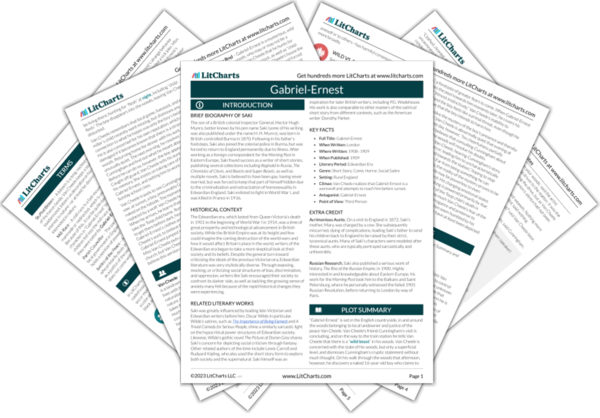Set in the English countryside, “Gabriel-Ernest” takes place in a natural environment which has been heavily reshaped by human life. The mystery of Gabriel-Ernest suggests that while humans may like to believe they control nature, the line between wild and domestic is actually thin and unpredictable .In fact, the very idea of a werewolf suggests that the clear division between wild and domestic is a false binary, and challenges the idea that humans can neatly separate them. Until Gabriel-Ernest’s arrival, Van Cheele sees the woods not as true wilderness, but a domesticated realm under his control. His stuffed bittern is emblematic of his relationship to nature. As the narrator sarcastically describes, Van Cheele’s interest in the natural life of the woods is aimed at providing fodder for conversation, not “assisting contemporary science,” and he is confident that there is nothing in the woods besides game and perhaps “A stray fox or two and some resident weasels. Nothing more formidable.” While Van Cheele is disturbed by his encounter with Gabriel-Ernest in the woods, his life is truly upended when Gabriel-Ernest shows up inside his house the next day. Ironically, and much to Van Cheele’s frustration, his aunt is utterly oblivious to Gabriel-Ernest’s wild nature, giving him his prim and proper new name and setting him to work in her Sunday school class, of all places. This comedic sequence of events goes to show that the line between the wild and the domestic, so important to Van Cheele’s worldview, is much less clearly defined than he thinks—and hopes—it is. What is clear, however, is that the sense of normalcy—and security—that Van Cheele took for granted before Gabriel-Ernest’s appearance may never return. As the mystery in the woods shows, humans can never really claim to have total knowledge—and with it, total control—over nature.
Wild vs. Domestic ThemeTracker

Wild vs. Domestic Quotes in Gabriel-Ernest
‘There is a wild beast in your woods,’ said the artist Cunningham, as he was being driven to the station. It was the only remark he had made during the drive, but as Van Cheele had talked incessantly his companion’s silence had not been noticeable.
‘A stray fox or two and some resident weasels. Nothing more formidable,’ said Van Cheele. The artist said nothing.
‘What did you mean about a wild beast?’ said Van Cheele later, when they were on the platform.
‘Nothing. My imagination. Here is the train,’ said Cunningham.
He had a stuffed bittern in his study, and knew the names of quite a number of wild flowers, so his aunt had possibly some justification in describing him as a great naturalist. At any rate, he was a great walker. It was his custom to take mental notes of everything he saw during his walks, not so much for the purpose of assisting contemporary science as to provide topics for conversation afterwards. When the bluebells began to show themselves in flower he made a point of informing every one of the fact; the season of the year might have warned his hearers of the likelihood of such an occurrence, but at least they felt that he was being absolutely frank with them.
‘You can’t live in these woods,’ said Van Cheele.
‘They are very nice woods,’ said the boy, with a touch of patronage in his voice.
‘But where do you sleep at night?’
‘I don’t sleep at night; that’s my busiest time.’
Van Cheele began to have an irritated feeling that he was grappling with a problem that was eluding him.
‘What do you feed on?’ he asked.
‘Flesh,’ said the boy, and he pronounced the word with slow relish, as though he were tasting it.
‘Flesh! What flesh?’
‘Since it interests you, rabbits, wild-fowl, hares, poultry, lambs in their season, children when I can get any; they’re usually too well locked in at night, when I do most of my hunting. It’s quite two months since I tasted child-flesh.’
‘Where’s your voice gone to?’ said his aunt. ‘One would think you had seen a wolf.’
Van Cheele, who was not familiar with the old saying, thought the remark rather foolish; if he had seen a wolf on his property his tongue would have been extraordinarily busy with the subject.
‘Suddenly I became aware of a naked boy, a bather from some neighbouring pool, I took him to be, who was standing out on the bare hillside also watching the sunset. His pose was so suggestive of some wild faun of Pagan myth that I instantly wanted to engage him as a model, and in another moment I think I should have hailed him. But just then the sun dipped out of view, and all the orange and pink slid out of the landscape, leaving it cold and grey. And at the same moment an astounding thing happened – the boy vanished too!’
‘What! vanished away into nothing?’ asked Van Cheele excitedly.
‘No; that is the dreadful part of it,’ answered the artist; ‘on the open hillside where the boy had been standing a second ago, stood a large wolf, blackish in colour, with gleaming fangs and cruel, yellow eyes.’











